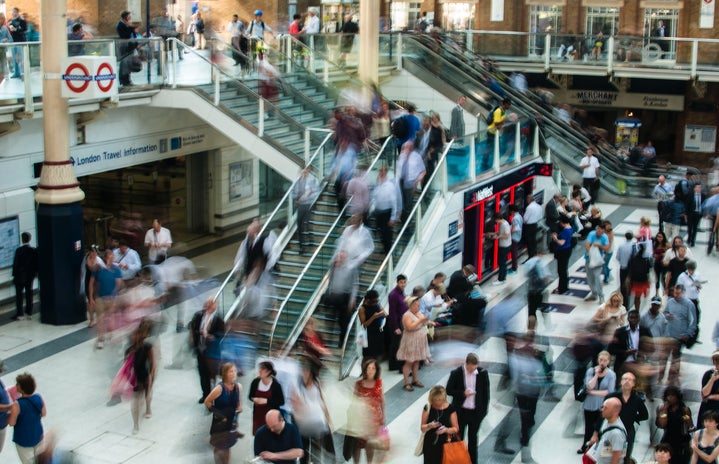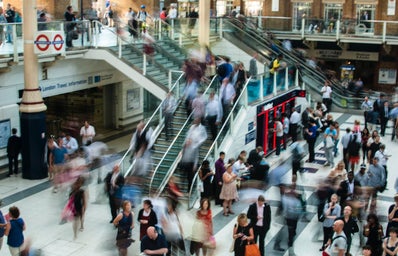I think we can agree that journeys on the London Underground aren’t very comfortable for anyone. It is particularly difficult for passengers – like myself – with neurodivergence and mental health conditions, especially with symptoms such as sound and touch sensitivity, social anxiety, ‘extreme impatience’, inability to deal with stress, emotional dysregulation and resistance to changes in routine. The loudness, overcrowding and unpredictability of London’s Tube services often trigger these symptoms and instead of taking us from A to B, take us from calm to total meltdown. In this article, I’ll shed light on specific failures in accessibility that I have encountered and reveal how I cope with problems that arise during journeys in London.
Changes we should be seeing
TFL is guilty of almost entirely neglecting people with non-physical disabilities. Sunflower lanyards or the ‘please offer me a seat’ badges don’t do enough to help. For some of the many glaring issues of London’s public transport, I have outlined a few improvements below that could change the way we all experience travel every day in the city.
Temperature moderation
It is especially hot on some Tube Lines in the summer – yes, Victoria, Central and Bakerloo, I’m talking about you! This can be very overwhelming for those with sensory issues or emotional dysregulation. Exposure to extreme heat can increase ‘irritability’ and some ‘psychiatric medications, including some antidepressants and antipsychotics, can affect the way a person’s body regulates temperature’. This constant exposure to high heat and humidity could be detrimental to the emotional regulation of many passengers with mental health conditions and neurodivergence, especially for longer journeys from Zone 1 to 5 or 6. Introducing air conditioning to more TFL services would help reduce these risks and protect the physical and emotional well-being of people with these conditions.
Quiet spaces
Clashing noises on public transport can be difficult to deal with for those like myself with a heightened sensitivity to sound – and I think we all deserve some peace and quiet after a busy day! Some ‘sound processing disorder[s]’ not only cause a higher sensitivity to sound but are also ‘characterized by the experience of strong negative emotions (anger and anxiety) in response to everyday sounds.’ It’s no wonder, then, that the mixture of talking, shouting, sniffling, chewing, and audible music and videos all at once causes complete sensory overload for some neurodivergent passengers. Quiet carriages on more long-distance routes would provide a safe haven and reduce the possibility of overstimulation for passengers with sensory issues.
Traffic control and punctual services
The crowded chaos of the Tube has previously brought on public meltdowns for me. On one occasion, there were such severe delays on the Piccadilly Line that I had to wait for three trains until I could squeeze on and endure the commute home, sandwiched between sweaty, irritable people. The only pole accessible was the one overhead, but because I’m so short, I couldn’t even reach it! Luckily for me, because no one could move at all, falling over was practically impossible. Being forced to touch so many strangers in such a humid environment sent me into sensory overload and increased my stress levels so greatly that I lost control of my emotions and struggled to safely navigate my way home. I can’t imagine how much worse that situation would have been for people with more severe sensory and emotional symptoms than myself.
Tube delays like this are one of the things making congestion worse because it means more passengers than usual are travelling on other lines to get around a delay, resulting in extreme overcrowding on platforms. Not all hope is lost, though. In 2016, Sadiq Khan said that his plans were and still are to enact ‘major station modernisation, new trains and signalling, [and] line extensions’. We can see his progress with the new Elizabeth line and the Piccadilly trains coming in 2025 – which I have to say I’m so excited for since it’s my most used Tube line.
While I very much doubt this decision was made with passengers with neurodivergence or mental health conditions in mind (since there was no mention of any accessibility benefits), the rollout of new trains like the Piccadilly ones will have a projected ‘10%’ more capacity, walkthrough carriages and even air conditioning – we should be so lucky! This will help neurodivergent passengers by reducing unwanted contact with other passengers in crowded carriages and regulating temperatures. And for people who struggle with disrupted routines or with symptoms like extreme impatience and restlessness, new trains typically have less frequent faults, so this should maximise their numbers and help services be on time.
Even though it’ll likely take many years for all trains to have these features – which leaves passengers with mental health conditions and neurodivergence struggling through this period – I’m hopeful that the modernisation of future trains and platforms will help the younger generation of neurodivergent people to feel less afraid to use public transport in London.



